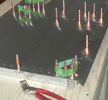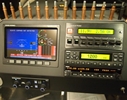


random user submitted photo
Ballistic Recovery System (Parachute)
Re: Ballistic Recovery System (Parachute)
Perhaps Sonex and BRS should take a second look at engineering a BRS solution. The Pipersport/Sportcruiser LSA has a BRS and that aircraft has a layout very similar to a Sonex.
Jake
Jake
-

SonexN76ET - Posts: 494
- Joined: Tue Aug 27, 2013 2:39 pm
- Location: Atlanta
Re: Ballistic Recovery System (Parachute)
SonexN76ET wrote:Perhaps Sonex and BRS should take a second look at engineering a BRS solution. The Pipersport/Sportcruiser LSA has a BRS and that aircraft has a layout very similar to a Sonex.
Jake
I bet they didn't retrofit the BRS into the Sportcruiser design.
John Gillis
SEL Private, Comm Glider, Tow pilot (Pawnee Driver)
Waiex N116YX, Jabiru 3300, Tail dragger,
First flight, 3/16/2013. 403 hours and climbing.
Home: CO15. KOSH x 5
Flying a B-Model Conversion (Super Bee Baby!)
-

fastj22 - Posts: 1594
- Joined: Sun Aug 21, 2011 5:56 pm
- Location: Mile High
Re: Ballistic Recovery System (Parachute)
SonexN76ET wrote:Perhaps Sonex and BRS should take a second look at engineering a BRS solution
Joe Norris - A Sonex Employee - already replied about that on this very thread, stating that they've looked into it multiple times: http://www.sonexbuilders.net/viewtopic.php?f=3&t=1797&start=30#p13313
--Noel
- NWade
- Posts: 527
- Joined: Mon Aug 08, 2011 3:58 pm
Re: Ballistic Recovery System (Parachute)
Not advocating for a BRS, and have not even given any a close look, but would think could run two cables, one from root of each wing spar routed back along outside of fuselage then up to top of turtle deck, joined, and then single cable down into turtle deck to the BRS. Then cover the exposed cables with something aerodynamic that would rip away if the BRS were deployed. Biggest hassle might be to find a way to insure that a wildly tumbling plane could not loop itself between those cables. Perhaps cables could be anchored at trialing edge of wing so as to rip loose from there only when fully chute opens ? Enough engineering talent on this forum to give the idea another look. Does not look simple, and likely to add more weight than we would want, but no harm in discussion.
David A.
David A.
- DCASonex
- Posts: 935
- Joined: Mon Sep 12, 2011 8:04 pm
- Location: Western NY USA
Re: Ballistic Recovery System (Parachute)
DCASonex wrote: Does not look simple, and likely to add more weight than we would want, but no harm in discussion.
In theory, the installation of a BRS could be very similar to the one on the Zenith 601/650, shown here. http://zenair.weebly.com/ballistic-parachute-kits.html. A Sonex would probably need a swing-back canopy if done this way, with quick-disconnect points for the canopy located inside just to be sure (wouldn't want to drop into the water and then not be able to get out.
All that is in theory. I don't think it's a good idea.
The weight is something to be considered carefully.
Rather than considering the BRS in isolation, we should think of the problem in terms of total risk management. With two average-size people aboard my plane and full fuel, I have about 35-40 lbs of available cargo weight. With a BRS (new attachment points and local "beefing up", cables, canopy, rocket, actuator mechanism, a new break-away panel and frame, etc) I could very well use all of that up. So in many cases, we'll be leaving stuff on the ground that we could take if we didn't have a BRS. Like fuel. Or a GPS/emergency radio. Etc. I wonder which would have saved more people, looking back at accident stats: the BRS or another gallon of fuel, a radio, a fire extinguider, or a lot of other things that couldn't be carried if we load up with a BRS. Just the small but measurable incremental loss of climb rate with the weight of a BRS aboard has a safety cost.
And the added BRS weight would probably be behind the CG--not a good place for most Sonexes. How does an increase risk in out-of-limits aft CG affect total safety? Not well. Further reduction in useable fuel (because some of it is now needed forward as ballast--also not good).
With a BRS, the Sonex would become either a two person plane with reduced fuel and no baggage, or a one person acft with no acro (CG limits, impractically small fuel allowance at acro weights for most pilots). That's a lot of utility to give up.
As Joe said--Sonex has looked at this and didn't see how it could be made to work well. I'd say if a person wants a BRS, it would be best to look for an acft design that included that provision from the start, or which can be made to accept it, But even then--look at total risk management. The Sonex design includes a lot of safety features (low stall speed, robust structure, very tough fuel cell, good handling, predictable and docile stall behavior, etc) that may do more to mitigate total risk than a BRS on another airplane.
Just my 2 cents.
Mark Waldron
Sonex 1230 (Builder: Jay Gibbs)
Aerovee, Trigear
Sonex 1230 (Builder: Jay Gibbs)
Aerovee, Trigear
- vigilant104
- Posts: 265
- Joined: Wed Nov 09, 2011 3:34 pm
- Location: Near Dayton, OH
Re: Ballistic Recovery System (Parachute)
Let's think outside the box. Instead of using the BRS to lower the entire airframe, just let it lower the passenger compartment. Build in a "pod", like the one that Sonex uses as a demonstrator. The pod contains the passengers, seat, and restraining belts. When the BRS deploys it pulls the pod out of the airframe and lowers it gently to the ground. EASY PEEZY :? :?
- radfordc
- Posts: 573
- Joined: Fri Jun 03, 2011 9:39 am
Re: Ballistic Recovery System (Parachute)
radfordc wrote: The pod contains the passengers, seat, and restraining belts. When the BRS deploys it pulls the pod out of the airframe and lowers it gently to the ground.
The Sonn-vaark? http://www.nationalmuseum.af.mil/factsheets/factsheet.asp?id=14319
"And the stick becomes a bilge pump handle . . "
Mark Waldron
Sonex 1230 (Builder: Jay Gibbs)
Aerovee, Trigear
Sonex 1230 (Builder: Jay Gibbs)
Aerovee, Trigear
- vigilant104
- Posts: 265
- Joined: Wed Nov 09, 2011 3:34 pm
- Location: Near Dayton, OH
Ballistic Recovery System (Parachute)
Ejection seats. Much simpler.
Robbie Culver
Sonex 1517
Chicagoland
Tails and Wings complete - finishing fuselage.
N1517S reserved
Robbie Culver
Sonex 1517
Chicagoland
Tails and Wings complete - finishing fuselage.
N1517S reserved
Robbie Culver
Sonex 1517
Aero Estates (T25)
First flight 10/10/2015
375+ hours
Jabiru 3300 Gen 4
Prince P Tip
Taildragger
N1517S
Sonex 1517
Aero Estates (T25)
First flight 10/10/2015
375+ hours
Jabiru 3300 Gen 4
Prince P Tip
Taildragger
N1517S
-

Sonex1517 - Posts: 1670
- Joined: Fri Jun 03, 2011 10:11 am
- Location: T25 Aero Estates, Frankston, TX
Re: Ballistic Recovery System (Parachute)
Learning how to handle emergency situations and concentrate on aviating, I.e. Flying the airplane to the ground = priceless!
The majority of the serious incodents and accidents I read about (not limited to Sonex) are pilot induced error (ignoring mechanical issues, not calculating the proper fuel burn, trying to make the impossible turn back to the runway, loss of spatial orientation, flight into IMC)...where only a few of these scenarios would be survivable with a BRS.
While this is an interesting thread to read everyone's "what if's" and "why nots" I don't see the point of it anymore other than for passing the time at the end of the cold winter...
just my opinion and two cents, and probably worth even less...
The majority of the serious incodents and accidents I read about (not limited to Sonex) are pilot induced error (ignoring mechanical issues, not calculating the proper fuel burn, trying to make the impossible turn back to the runway, loss of spatial orientation, flight into IMC)...where only a few of these scenarios would be survivable with a BRS.
While this is an interesting thread to read everyone's "what if's" and "why nots" I don't see the point of it anymore other than for passing the time at the end of the cold winter...
just my opinion and two cents, and probably worth even less...
Scott Meyer
Sonex 1629 - Sold...9/2019
Sonex 1629 - Sold...9/2019
- ScottM-Sonex1629
- Posts: 441
- Joined: Sun Aug 11, 2013 10:00 pm
- Location: Dublin, Ohio (MRT)
Re: Ballistic Recovery System (Parachute)
If I had the money for a Cirrus, and the chute made my wife willing to fly, it would be awesome. Of course none of that will happen and I will be happy in my BRS-less Waiex.
Bryan Cotton
Poplar Grove, IL C77
Waiex 191 N191YX
Taildragger, Aerovee, acro ailerons
dual sticks with sport trainer controls
Prebuilt spars and machined angle kit
Year 2 flying and approaching 200 hours December 23
Poplar Grove, IL C77
Waiex 191 N191YX
Taildragger, Aerovee, acro ailerons
dual sticks with sport trainer controls
Prebuilt spars and machined angle kit
Year 2 flying and approaching 200 hours December 23
-

Bryan Cotton - Posts: 5493
- Joined: Mon Jul 01, 2013 9:54 pm
- Location: C77
Who is online
Users browsing this forum: Bing [Bot] and 3 guests







